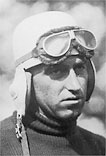 Ray Weishaar was one of the best known and most popular motorcycle racing stars of the 1910s and 1920s. He rode the board and dirt tracks of the country on Harley-Davidsons. Weishaar was fatally injured on April 13, 1924, while competing at Ascot Speedway in Los Angles.
Ray Weishaar was one of the best known and most popular motorcycle racing stars of the 1910s and 1920s. He rode the board and dirt tracks of the country on Harley-Davidsons. Weishaar was fatally injured on April 13, 1924, while competing at Ascot Speedway in Los Angles.
Weishaar's death, along with the racing death of Gene Walker two months later, prompted a movement by the manufacturers to slow down the speeds of the racing machines of the day. Classes for smaller engines were implemented, but as is usually the case racing, speeds continued to climb.
Born Lawrence Ray Weishaar on September 9, 1890 in Oklahoma, he grew up in Wichita, Kansas. When he was 9, his father died leaving the Weishaar family in financial peril. Weishaar had to go to work to help the family. In his late teens, Weishaar took a job with Bell Telephone and earned enough money to buy a motorcycle which, before the days of Ford's Model T, was the cheapest mode of transportation.
Racing on the half-mile county fair circuits of Kansas from 1908 to 1910, Weishaar was dubbed the "Kansas Cyclone." He earned the Kansas State Championship two years in a row. The second year, one side of his bike's handlebar broke off and he was still able to win the race, although it was duly noted that he didn't break his previous year's record.
By 1914, Weishaar began racing on the national circuit. His first big event was the national in Savannah, Georgia. He ran with the leaders, but on the 24th lap his gas tank developed a leak and he was forced to retire from the race. A faulty spark plug fouled his chances at the 1915 Dodge City 300. That same year he won a 300-mile race at the Chicago Speedway and a 100-miler in Pratt, Kansas.
Weishaar became part of the Harley-Davidson factory team in 1916. He finished third at Dodge City that year and won the FAM 100-Mile Championship in Detroit. Also that year he was offered a Harley-Davidson dealership and became a dealer for three years. Weishaar didn't have racing out of his system, though, and he returned to the circuit in 1919.
The biggest win of his career came in the Marion (Indiana) Cornfield Classic Road Race in 1920. Not only did Weishaar win the race, he also lowered the race record by nearly 18 minutes.
Weishaar was known as a careful rider and one who suffered a lot of tough luck. He led many nationals only to have his machines fail him. Weishaar signed a contract to race at the newly built Ascot Speedway in 1923 and moved to Los Angeles.
In the crash that proved fatal to Weishaar, he was battling Gene Walker for the lead. Johnny Seymour drafted past both Walker and Weishaar, sending Weishaar's bike into a high-speed wobble. The bike went into a skid and he fought to save it before hitting the outside fence. Weishaar went through the wooden fence and was still conscious and not thought to be seriously hurt. His wife, Emma, drove him to Los Angeles General Hospital where he died just hours later from internal injuries.
Many of the top racers of the day attended Weishaar's funeral. His close friend, Jim Davis, was a pall bearer. Weishaar was laid to rest at Inglewood Park Cemetery in California.
The racing community rallied to the aid of Weishaar's surviving wife and six-month-old son and paid off the house which the Weishaars were buying.